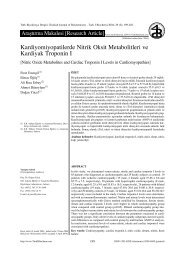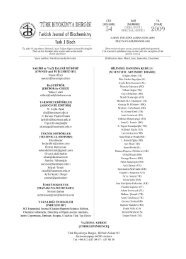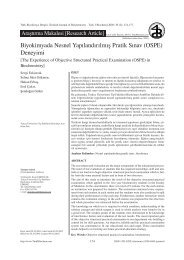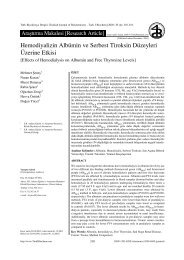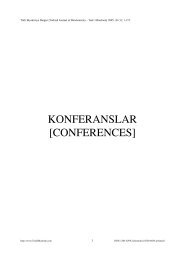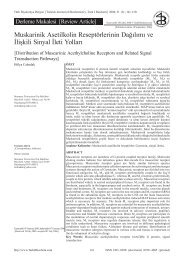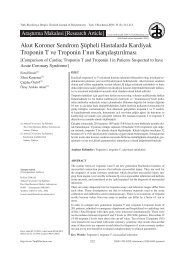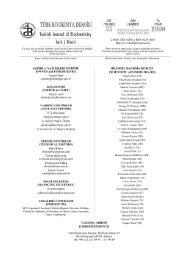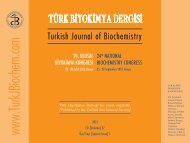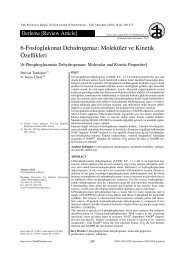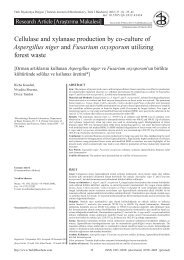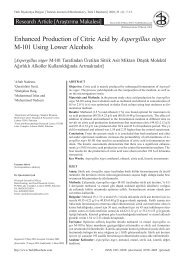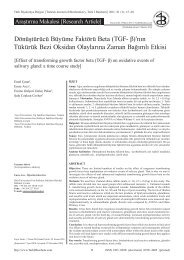23. Ulusal Biyokimya Kongresi Ãzel Sayısı - Türk Biyokimya Dergisi
23. Ulusal Biyokimya Kongresi Ãzel Sayısı - Türk Biyokimya Dergisi
23. Ulusal Biyokimya Kongresi Ãzel Sayısı - Türk Biyokimya Dergisi
Create successful ePaper yourself
Turn your PDF publications into a flip-book with our unique Google optimized e-Paper software.
XXIII. ULUSAL B‹YOK‹MYA KONGRES‹<br />
29 Kasım - 2 Aralık 2011<br />
Hilton Hotel - Adana<br />
<strong>23.</strong> <strong>Ulusal</strong> <strong>Biyokimya</strong> <strong>Kongresi</strong>, Adana [23 rd National Biochemistry Congress, Adana / TURKEY]<br />
İÇİNDEKİLER<br />
DAVETLİ KONUŞMACI ÖZETLERİ<br />
OZONUN ANTİOKSİDAN MEKANİZMALARI VE TEDAVİDE<br />
KULLANILMASI<br />
Mine İNAL<br />
Osmangazi Üniversitesi, Tıp Fakültesi, <strong>Biyokimya</strong> Anabilim Dalı, Eskişekir<br />
Ozon reaksiyondaki karşılaştığı biyomoleküllere bağlı olarak farklı mekanizmalar<br />
verir. Organik reaksiyon katılımcılarının varlığında ozon belirgin biçimde seçici<br />
bir reaksiyon dizisi gösterir. Genellikle serbest radikal ve iyonik mekanizmaları ile<br />
birlikte gider. Fizyolojik koşullarda tam kanda reaksiyon mekanizmaları, esansiyel yağ<br />
asitlerinin karbon-karbon çift bağına ek olarak 1,3-dipolar şeklindedir. Kanın hücresel<br />
elemanlarından alyuvarların membran bileşenlerini alan doymamış yağ asitleri ozonun<br />
tercih edilen reaksiyon parametreleridir. Ozonun sistemik uygulamasında, tıbbi<br />
ozonun etkisiyle oluşan peroksitler ozonun etki mekanizmasında önemli yer tutar.<br />
Özellikle alyuvarlarda yarattığı oksidatif etkiye antioksidatif enzimleri aktive ederek<br />
cevap verir. Enfekte ülserlerin lokal tedavisinde, ozon veya ozon peroksitlerinin ozon<br />
konsantrasyonuna bağlı olan etkisi hemen ortaya çıkar. Ozonitler ve ozon peroksitleri,<br />
ozonize yağlarda O3 reaksiyon ürünleri biçiminde korunur ve yara iyileşmesinde etkili<br />
olur. Tedavi dozlarında organizmadaki peroksidasyon reaksiyonlarına karşı katılan<br />
enzimler aktive olur. Peroksit ve oksijen radikalleri üzerindeki dejeneratif sonuçlara<br />
karşı koruyucu bir fonksiyon üstlenirler. Süperoksit dismutaz, fazla süpeoksit<br />
radikallerinin, katalaz hidrojen peroksit ve glutatyon peroksidaz ozon peroksitler veya<br />
organik peroksitlerin parçalanmasından sorumludur. Redükte glutatyon gibi ozon<br />
peroksitleri hem radikal yakalayıcı hem de iyonlarla raksiyona girerler. Antioksidatif<br />
enzimlerden başka alyuvar hücrelerindeki diğer enzimler örneğin glukoz-6-fosfat<br />
dehidrogenaz gibi enzimler ve heksoz monofosfat yolu gibi metabolik yollar da aktive<br />
olur.<br />
Anahtar Kelimeler: ozon, oksidatif stres<br />
OZONE THERAPY: CLINICAL AND BASIC EVIDENCE OF ITS<br />
THERAPEUTIC POTENTIAL<br />
Mine İNAL<br />
Department of Medical Biochemistry, Faculty of Medicine, Osmangazi<br />
University, Eskişekir<br />
Ozone has recently been subjected to criticism and emphasis in relation to clinical<br />
efficacy and toxicity, respectively. Without a doubt, ozone, in common with oxygen<br />
itself, is one of the major pollutants in urban areas. Nevertheless, inereasingly<br />
widwspread use lately has highlighted the potential benefits as a therapeutic agent<br />
when used according to well-defined and safe protocols. In recent years, emphasis and<br />
attention has been focused on the use of medical ozone. Despite ample clarification<br />
(1), confusion persists concerning its potential toxicity as an oxidant agent us the<br />
reported clinical efficacy. This confusion is a major factor preventing a more widespred<br />
acceptance. Furthermore, the use in specialties so diverse as neurology, orthopedics,<br />
internal medicine, sports medicine, endocrinology and others makes is difficult to<br />
categorize ozone as a therapeutic agent. This may cause conflicts between the different<br />
fields of application and the various medical areas. Ozone, at nontoxic deses, can<br />
induce a rearrangement of the biochemical pathways with the activation of a second<br />
Messenger in a cascade with a multiple system action. Ischemic preconditioning<br />
represents the best similarity in this. Diabetes produces a large number of chenges<br />
in vessles that affect the reactivity of smooth muscle and endothelium. Vascular<br />
endothelium appears to be a vulnerable target for hyperglycemia-induced metabolic<br />
changes. Ozone has been used as a therapeutic agent and beneficial effects have been<br />
observed. However, so far only a few biochemical and pharmacodynamic mechanisms<br />
have been elucidated. Given that diabetes is a disorder associated with oxidative stres,<br />
it was postulated that ozone treatment might protect antioxidant systems and maintain<br />
at a physiological level other markers of a endothelial cell damage associated with<br />
diabetic complications. Ozone antioxidant properties preserved beta-cell functions<br />
and reduced hyperglycemia. Together, these results suggest that this approach may<br />
represent a potential complement in the treatment of diabetes its complications. Many<br />
studies indicate that, after reoxygenation of the liver, oxygen free-radical formation<br />
may initiate the cascade of hepatocellular injury, necrosis/apoptosis and subsequent<br />
infiltration of inflammatory cells. Superoxide is one of the most relevant radical in<br />
biological regulation. Many regulatory effects are nediated by hydrogen peroxide and<br />
other ROS that are chemically derived from superoxide.<br />
CONTENTS<br />
ABSTRACTS OF INVITED LECTURES<br />
Turk J Biochem, 2011; 36 (S2)<br />
http://www.TurkJBiochem.com



